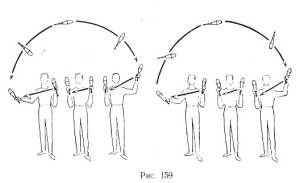|
Scenically
Developed Club Lessons
from Die Kunst des Jonglierens by Nikolai Ernestowitsch Bauman
Note:
This is the third in a series. begun
At
amateur collectives it often happens that more participants would like
to participate in the
After
the announcer has indicated the number and the orchestra has played an
introductory melody, all participants walk to the stage. Each holds
three clubs in his hands. They walk to the front of the stage, bow to
the audience and begin, all in one row beside each other, individually
juggling with three clubs.
To
begin they throw single turns and then double turns. They can,
however, depending upon the preparedness of the participants,
demonstrate other moves. After all actors have juggled in this manner
for a little while, they return to juggling the clubs with single
turns and then without interrupting the juggling or changing their
position, on command they begin to juggle in pairs.
Number
One throws the clubs with Two, Three with Four, Five with the Six -
the -
see figure 122 (left drawing).]
When
the actors have completed this juggling trick, they move on to three
cascades. To do this, One throws not to Two but to Three. The clubs
are now
Two
passes a club from his right hand to the left hand of One (see
figure 159 (middle drawing)).
The second "troika" of jugglers does the same trick as the first, that is, Four throws to Six with triple turns, Six gives it to Five, and so on. After all participants have juggled in this manner for a while, upon command they switch to juggling individually with single turns. Without interrupting the juggling, the participants now change their position.
They
form two rows. (The individuals must continue to juggle with the same
And
then One and Six turn so that they are facing each other. The distance
between the participants must be calculated so that the clubs do not
come in contact with each other while juggling. As a result of their
movements you now have two rows of people facing each other on the
stage. See
figure 160 (right drawing). If
necessary the two rows should step a bit nearer to each other. The
combined juggling of both rows begins on a command (or after a counted
number of throws). One throws his first club to Six, the second he
keeps (that is, he juggles it at the set rhythm). Six throws his first
club to One and the second club to Two and continues to alternate
between them. Two throws his first club to Five, second club to Six,
and then continues to alternate between them.
Five
throws his first club to Two, the second club to Three. Three passes
his first club to Four, and second club to Five, and Four juggles his
first club to Three, and his second club he keeps. All participants
pass the clubs with single turns. (The
patterns which complete this section will be included in a later
issue.)
|


